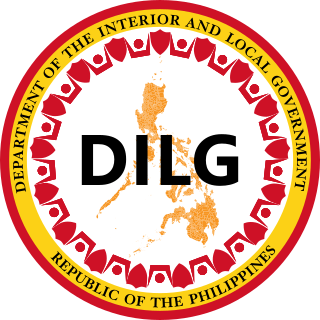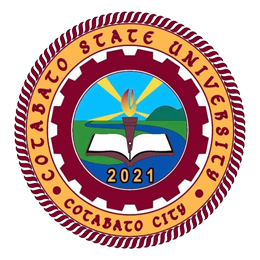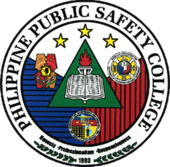
The Armed Forces of the Philippines (AFP) are the military forces of the Philippines. It consists of three main service branches; the Army, the Air Force, and the Navy. The President of the Philippines is the Commander-in-Chief of the AFP and forms military policy with the Department of National Defense, an executive department acting as the principal organ by which military policy is carried out, while the Chief of Staff of the Armed Forces of the Philippines serves as the overall commander and the highest-ranking officer in the AFP.

Panfilo "Ping" Morena Lacson Sr. is a Filipino former politician and police general who served as a Senator for three terms: from 2001 to 2013 and from 2016 to 2022. He was the Director General of the Philippine National Police (PNP) from 1999 to 2001, and was a candidate in the 2004 and 2022 Philippine presidential elections.

The Philippine National Police is the armed national police force in the Philippines. Its national headquarters is located at Camp Crame in Bagong Lipunan ng Crame, Quezon City. Currently, it has approximately 228,000 personnel to police a population in excess of 100 million.

The Philippine Coast Guard (PCG) is the third armed uniformed service of the country attached to the Philippines' Department of Transportation, tasked primarily with enforcing laws within Philippine waters, conducting maritime security operations, safeguarding life and property at sea, and protecting marine environment and resources; similar to coast guard units around the world. In case of a declaration of war, the Coast Guard shall also serve as an attached service of the Department of National Defense.

A police academy, also known as a law enforcement training center, police college, or police university, is a training school for police cadets, designed to prepare them for the law enforcement agency they will be joining upon graduation, or to otherwise certify an individual as a law enforcement officer, typically a police officer.

The Philippine Statistics Authority is the central statistical authority of the Philippine government that collects, compiles, analyzes, and publishes statistical information on economic, social, demographic, political affairs, and general affairs of the people of the Philippines, as well as enforcing the civil registration functions in the country.

The National Police Commission is an agency attached to the Department of the Interior and Local Government (DILG) responsible for the administration and control of the Philippine National Police (PNP). It has the authority to administer police entrance examination, to investigate police anomalies and irregularities, and to summarily dismiss erring police officers.

An agriculturist, agriculturalist, agrologist, or agronomist is a professional in the science, practice, and management of agriculture and agribusiness. It is a regulated profession in Canada, India, the Philippines, the United States, and the European Union. Other names used to designate the profession include agricultural scientist, agricultural manager, agricultural planner, agriculture researcher, or agriculture policy maker.

The Department of the Interior and Local Government, abbreviated as DILG, is the executive department of the Philippine government responsible for promoting peace and order, ensuring public safety and strengthening local government capability aimed towards the effective delivery of basic services to the citizenry.

Science and technology in the Philippines describes scientific and technological progress made by the Philippines and analyses related policy issues. The main agency responsible for managing science and technology (S&T) is the Department of Science and Technology (DOST). There are also sectoral councils for Forestry, Agriculture and Aquaculture, the Metal Industry, Nuclear Research, Food and Nutrition, Health, Meteorology, Volcanology and Seismology.

Juan Edgardo "Sonny" Manalang Angara is a Filipino politician and lawyer serving as a Senator since 2013. He is the principal author and sponsor of Republic Act No. 11981 also known as the Tatak Pinoy Act, a landmark law for establishing a policy platform for the public and private sectors to collaborate to help domestic enterprises become more globally competitive and offer more diverse and sophisticated products and services. He is also the chairman of Samahang Basketbol ng Pilipinas, the governing body of basketball in the Philippines.
The National Counter-Terrorism Action Group was formed on November 27, 2007, with its existence announced to the public on November 29, 2007. It is a counter-terrorism body under the Anti-Terrorism Council. NACTAG is under the direct command of the National Security Advisor.
Northwest Samar State University is a public university in the Philippines located in Calbayog with extension campus in San Jorge, Samar. It is mandated to provide advanced education, higher technological, professional instruction and training in trade, fishery, agriculture, science, education, commerce, engineering, forestry, nautical courses and other related fields. It is also mandated to undertake research and extension services, and provide progressive leadership in its areas of specialization. Its main campus is in Calbayog.

Cotabato State University or CotSU, formerly Cotabato City State Polytechnic College, is a government-funded higher education institution located in Cotabato City, Philippines. It is mandated to provide professional and advanced vocational instruction and training in agriculture, fisheries, forestry, science and technology, engineering, and industrial technologies. It is also mandated to promote research, advanced studies, and progressive leadership in its field of specialization. Its main campus is located in Cotabato City.
The Philippine National Police Academy or PNPA, is a public safety school whose graduates are assigned as officers of the Philippine National Police (PNP), Philippine Public Safety College (PPSC),Bureau of Jail Management and Penology (BJMP) and the Bureau of Fire Protection (BFP). The PNPA was established on August 26, 1977, under Section 19, PD 1184 and was tasked to provide tertiary level education for Filipinos aspiring to be officers in the three bureaus of the Department of the Interior and Local Government.

The Food and Drug Administration (FDA) of the Philippines, formerly the Bureau of Food and Drugs, is a health regulatory agency under the Department of Health created on 1963 by Republic Act No. 3720, amended on 1987 by Executive Order 175 otherwise known as the "Food, Drugs and Devices, and Cosmetics Act", and subsequently reorganized by Republic Act No. 9711 otherwise known as "The Food and Drug Administration Act of 2009". The agency is responsible for licensing, monitoring, and regulation of cosmetics, drugs, foods, household hazardous products, medical devices and electromagnetic radiation emitting devices, pesticides, tobacco and related products, and vaccines for safety, efficacy, and quality in the Republic of the Philippines.
Mel Senen Sevilla Sarmiento is a Filipino politician. He was a member of the Philippine House of Representatives representing the 1st Legislative District of Samar from 2010 to 2015. He also served as Secretary-General of the Liberal Party. He served as the Vice Mayor of Calbayog from 1992 to 1995 and Mayor from 2004 to 2011 before the death of Congressman Uy. He was also the Secretary General of the League of Cities of the Philippines from 2004 to 2010. He also served as the last Secretary of the Interior and Local Government under President Benigno Aquino III after Jesse Robredo and Mar Roxas.

The Philippine National Police Maritime Group (PNP-MG) is a National Operational Support Unit (NOSU) of the Philippine National Police mandated to perform all police functions, ensure public safety and internal security over Philippine territorial waters, rivers and coastal areas to include ports and harbors and sustain the protection of the maritime environment. The unit was created along with the PNP by virtue of Republic Act RA 6975 otherwise known as Department of the Interior and Local Government Act of 1990 :

The Bureau of Fire Protection is the government body in the Philippines responsible for the provision of fire services. It is under the jurisdiction of the Department of the Interior and Local Government.
The Philippine Public Safety Academy or PPSA, is a public safety school whose graduates are assigned as officers of the Bureau of Jail Management and Penology (BJMP) and the Bureau of Fire Protection (BFP).



















